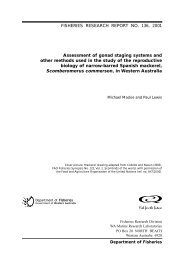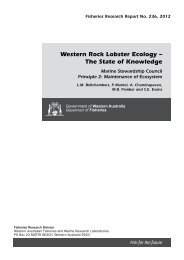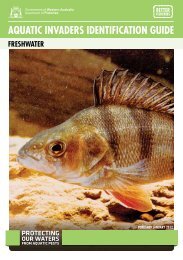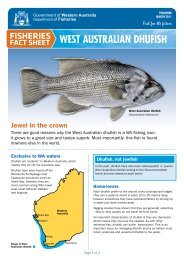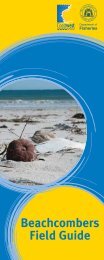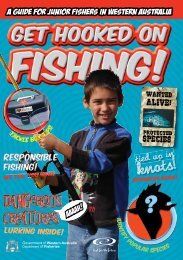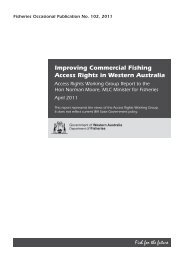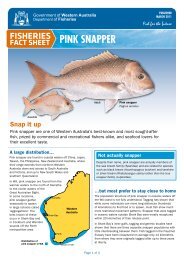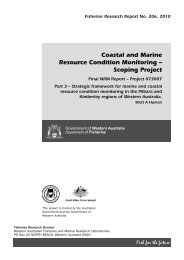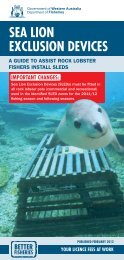Identifying Freshwater Crayfish - Department Of Fisheries Western ...
Identifying Freshwater Crayfish - Department Of Fisheries Western ...
Identifying Freshwater Crayfish - Department Of Fisheries Western ...
Create successful ePaper yourself
Turn your PDF publications into a flip-book with our unique Google optimized e-Paper software.
Koonac (two species in WA)<br />
Koonacs are also relatively large freshwater crayfish, growing<br />
up to 200 mm in total length. However, their distribution is<br />
further inland than that of marron, and they are often found in<br />
seasonal rivers and swamps that dry-up during summer.<br />
Koonacs survive drought because they can burrow and remain<br />
there for months at a time.<br />
Koonacs have four keels on the head and two are very<br />
prominent. Koonacs have no spines on the rostrum or telson.<br />
The chelipeds (claws) are unique, being very broad and<br />
serrated on the inside edge.<br />
Koonacs are usually very dark in colour, ranging from blueblack<br />
to mottled brown-black.<br />
Yabby<br />
Yabbies are an introduced species to WA. They are native<br />
to New South Wales, Victoria and South Australia, and were<br />
stocked into farm dams in WA in 1932. Yabbies can now be<br />
found in some south-west rivers and dams.<br />
Yabbies are much smaller than marron – very few yabbies<br />
grow to 130 mm in length. Yabbies can range from a beige or<br />
coffee colour to almost black. They can also take on a blue<br />
colour when held in aquariums for a long time.<br />
Their head has four keels, with two keels being very obvious,<br />
and have a short rostrum with no spines. The inner edges of<br />
the chelipeds (claws) have a mat of very obvious hairs not<br />
found on other crayfish species in WA.<br />
Yabbies are a threat to the marron fishery, as they breed<br />
faster than marron and may carry diseases that affect other<br />
freshwater crayfish. Help preserve native species; never<br />
release yabbies into rivers, lakes and dams and do not use<br />
them as live bait. If you catch a yabby, keep it.<br />
References<br />
Websites:<br />
<strong>Department</strong> of <strong>Fisheries</strong>, <strong>Western</strong> Australia<br />
www.fish.wa.gov.au<br />
<strong>Freshwater</strong> Fish Distribution in WA<br />
freshwater.fish.wa.gov.au<br />
This fact sheet is the twenty third (No. 23)<br />
in a <strong>Department</strong> of <strong>Fisheries</strong> series. ISSN 1834-9382<br />
Page 4 of 4<br />
Koonac photo and illustrations<br />
Yabby photo and illustrations<br />
FURTHeR INFORMATION<br />
Visit the <strong>Department</strong>’s website at<br />
www.fish.wa.gov.au or contact:<br />
DePARTMeNT OF FISHeRIeS – HeAD OFFICe<br />
3rd Floor, The Atrium,<br />
168 St George’s Terrace, Perth 6000<br />
Ph (08) 9482 7333 Fax (08) 9482 7389<br />
e-mail: headoffice@fish.wa.gov.au<br />
ABN: 55 689 794 771<br />
P&A132 OCT 2011



